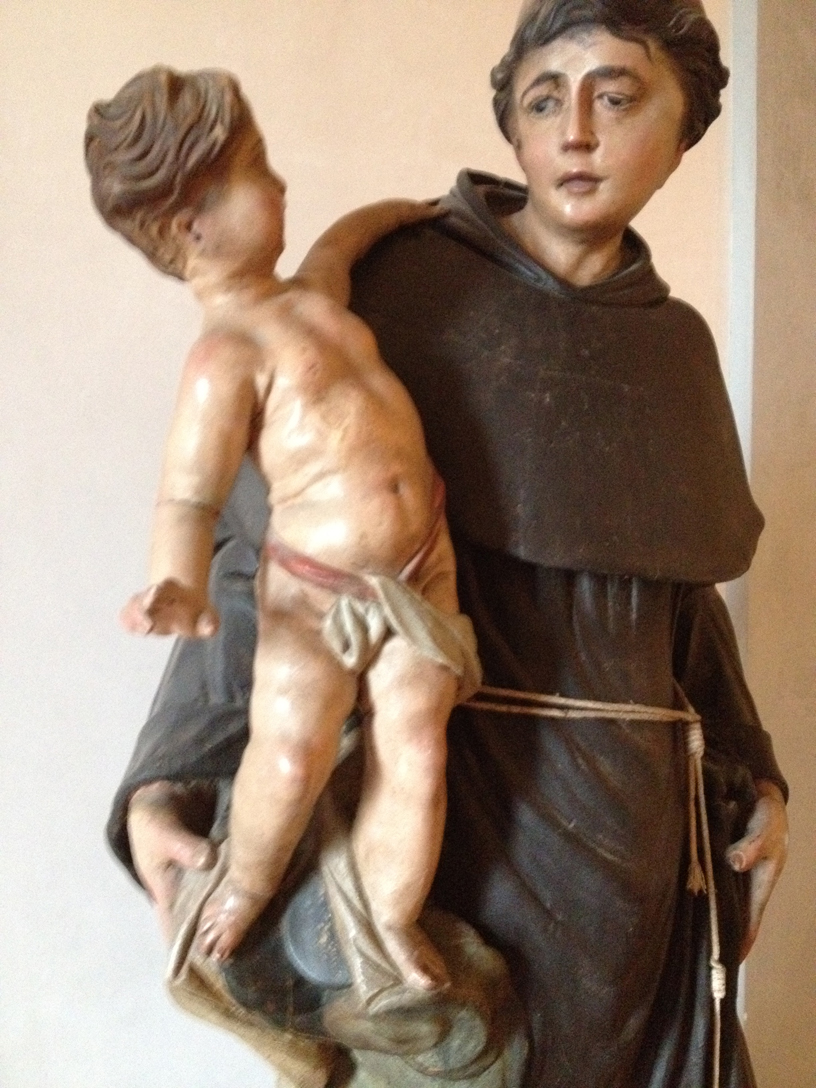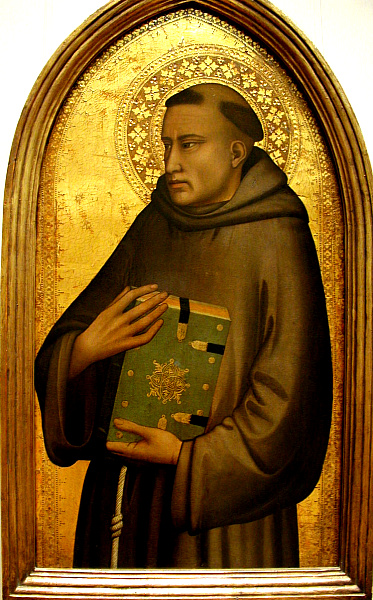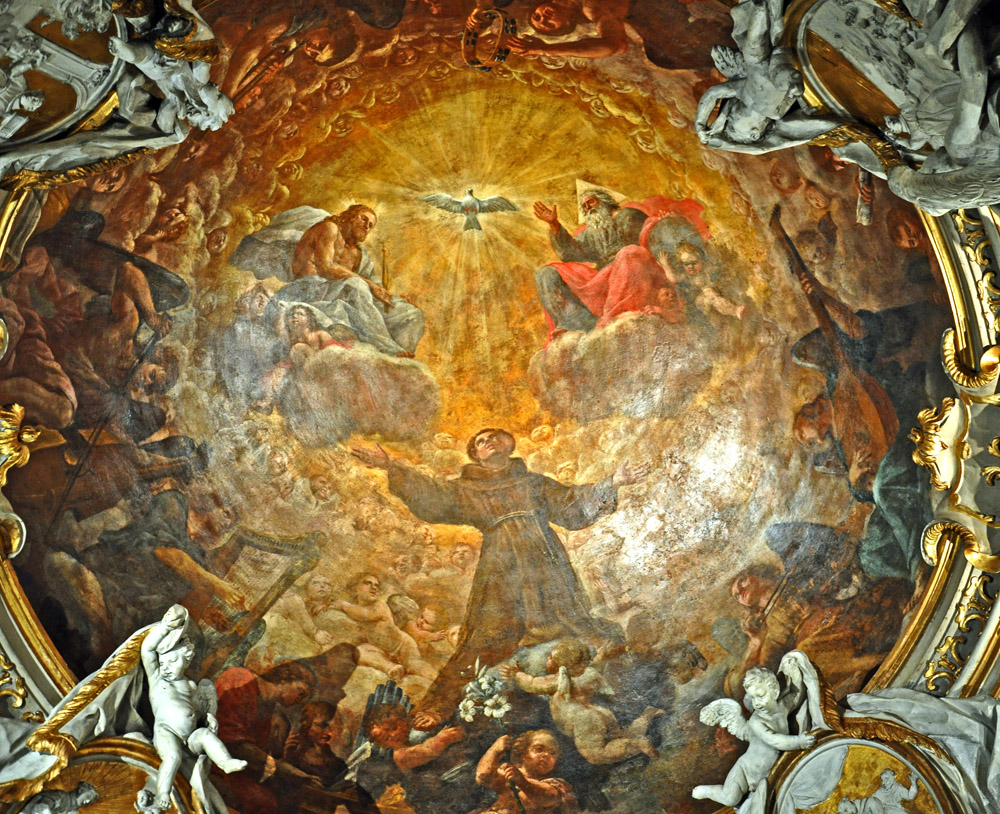PORTRAITS
Those who have visited any number of Catholic churches will be familiar with the representation of St. Anthony of Padua as a young Franciscan holding the Christ Child on one arm, as at right. This tradition is based on a vision of the Christ Child that the saint is said to have had while staying with a nobleman. The man peeked into the room he had provided for Anthony and saw him holding the Child in his arms.2
This account did not enter the iconography until the 16th century, and even then the child is shown placed upon the book that had until then always been Anthony's most common attribute (example). The book references Anthony's standing as the most famous preacher of his time and the Franciscan order's first Lector in Theology.3 The earliest images are like the second picture at right, with a closed book and the tonsure and habit of the Franciscan order.
The habit is sometimes pictured as gray, more often as brown. In the 18th century some Franciscans wore blue to mark their advocacy of the Immaculate Conception; thus St. Anthony wears blue in a nun's badge from 18th-century Mexico. The habit always includes a rope belt with three knots tied into the part that hangs down, referencing the Trinity.
After the child became a common feature, many painters put him on the opened pages of the book, as if he had appeared to Anthony while the saint was meditating on the scriptures (example). In one stained glass window the child appears in a vision while Anthony is kneeling in prayer before a book. In other images he may be reaching for Anthony from the lap of Mary (example) or St. Joseph (example).
The child is variously portrayed as a toddler (example), a boy (example), or even a small-scale man (example).
Because of the legend that he had once preached to the fish, these were sometimes used as his attribute (example).4 He is also often seen with a lily stalk (example), which in one painting is given him by St. Joseph. Another convention denotes St. Anthony's visionary fervor by means of a red heart held up in the right hand (example), sometimes aflame (example).
In former Venetan areas Anthony often figures in group paintings – anachronistically welcoming into Heaven martyrs from ancient times (examples: Zanchi, 17th century, Loth, 18th century) and assisting at the Exaltation of the True Cross (example). His image seems to have functioned as a sort of secondary symbol for the Venetian Republic with its dependencies, appearing in commission booklets used to appoint governors in the 17th century.
Anthony is also shown interceding with Mary and the Christ Child for souls in Purgatory (example). This subject is possibly related to the story, briefly mentioned in his vita, of a nun who feared Purgatory but who through the prayers of Anthony was able to be cleansed in this life, or perhaps to the more numerous and fully detailed accounts of the saint coming from Heaven to counsel women in despair of their salvation.5
NARRATIVE IMAGES
Considering the large number of Anthony portraits and statues in Italy and America, there are surprisingly few narrative images. One of the more popular types represents the "Miracle of the Mule": A Catharist said he would believe in the Real Presence only if a dumb animal were to prefer the consecrated host to a bundle of feed. Anthony arranged for a mule to be brought forward and given that choice. Sure enough, the mule went to the host and knelt down in adoration (example).6
Another story sometimes illustrated is the miracle of the severed foot. Misunderstanding the saint, a youth amputated his own foot, which Anthony then re-attached through prayer. The story is illustrated in this painting in Venice and in this predella in Dubrovnik, which also illustrates three other events in the saint's life.
Prepared in 2014 by Richard Stracke, Emeritus Professor of English, Augusta University, revised 2015-08-02, 2017-02-11, 2018-12-29, 2021-01-06.
HOME PAGE

18th-century statue of St. Anthony in San Leo, Italy (See the description page.)

Maso di Banco, St. Anthony of Padua, first half of the 14th century (See description page)

Baroque buildings often featured an apotheosis or "glory" image in the dome. This Glory of St. Anthony of Padua is in the ceiling of a chapel in Ravenna. (See description page)
ATTRIBUTES
- Before the 16th century: a book, a fish.
- 16th onward: the Christ Child, either on a book or embraced by the saint; lilies on a stalk or in a vase.
- All periods: broad tonsure, Franciscan habit (usually brown), rope belt with three knots in the part that hangs down.
MORE IMAGES
- 2nd half of the 13th century: A diminutive figure of St. Anthony is pictured between St. John the Baptist and St. John the Evangelist on the right side of the apse mosaic at St. John Lateran in Rome. It corresponds to a figure of St. Francis of Assisi on the left side. These two Franciscan saints are said to have been included by order of Pope Alexander IV (1254-61), who was himself a Franciscan.7
- 15th century: The Vesting of St. Anthony of Padua, probably by Giovanni di Paolo.
- 1505: Anthony of Padua is one of three saints in a high relief in Santa Maria del Popolo, Rome.
- 1540: The Christ Child reaches for Anthony to hold him in Tintoretto's Madonna and Child with Saints.
- 17th/18th century: Litterini's St. Anne with St. Joseph and St. Anthony of Padua is one of several from this period that associate Joseph and Anthony through the lily symbol.
- 1722-23: Anthony prays at an altar as the Madonna and Child look down from Heaven in Niccolò Bambini's The Virgin and Saints.
- 1749: In Velázquez's Sacra Conversazione the Christ Child leans out from Mary's lap toward St. Anthony of Padua.
- Second half of the 18th century, St. Anthony was a popular figure on badges worn by Mexican nuns: examples by Martínez, Páez, and Herrera.
- 19th century: In Sebastiano Santi's Crucifixion with Saints Saint Anthony of Padua and others contemplate Christ on the cross.
DATES
- Feast day: June 13
- Lived 1195-1231
NAMES
- Also known as St. Anthony of Lisbon
BIOGRAPHY
- Arnald of Sarrant, Chronicle of the Twenty-Four Generals
- Anthony's vita in The Roman Breviary: English translation, III, 625-26; Latin original, 888-89
- Acta Sanctorum , June volume 2, 703-738.
NOTES
1 Butler II, 534-7. Acta Sanctorum, June volume 2, 705-707.
2 Arnald, 180. Acta Sanctorum, ibid., 729 ¶ 24.
3 Butler II, 535. Arnald, 177. Acta Sanctorum, ibid., 728 ¶ 20.
4 Arnald, 163-5. Acta Sanctorum, ibid., 724-5.
5 Acta Sanctorum, ibid., 717 ¶ 45 and 735-37.
6 Arnald, 165-7. Acta Sanctorum, ibid., 725. See Wikimedia Commons for a predella relief in Barcelona and a fresco in Milan. Also see Giorgi, 39, for a painting of the miracle in Milan's Diocesan Museum.
7 Robson, 23.